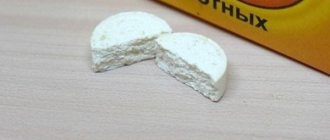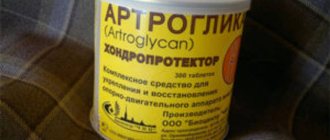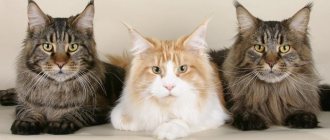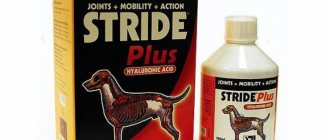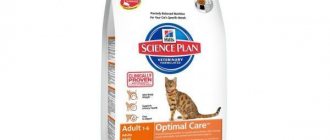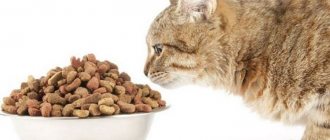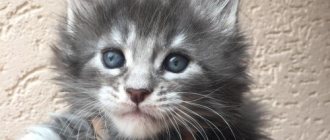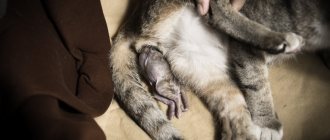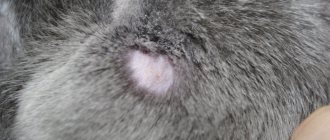Pets often suffer from diseases that are considered purely human. Not everyone knows that furry pets can suffer from destruction and inflammation of the joints and problems with the spine. To treat such ailments, medications have been created that can restore joint and cartilage tissue. They are called chondroprotectors. One such remedy is Arthroglycan.
- 2 For what diseases is it prescribed?
- 3 How Artroglycan acts on the body
- 4 Features of use in cats
- 5 Possible side effects and contraindications
- 6 Are there analogues of Artroglycan
6.1 Table: Arthroglycan analogues
- 6.2 Photo gallery: analogues of the drug
Artroglycan: composition, release form, storage conditions of a veterinary drug
The drug contains the following components:
- 200 mg chondroitin sulfate;
- 100 mg glucosamine hydrochloride;
- 50 mcg selenomethionine;
- 20 mg vitamin E;
- 100 mg calcium gluconate.
Artroglycan is sold in veterinary pharmacies in the form of tablets, which can be packaged in blisters of 30 pieces and in plastic jars of 300 pieces.
Storage conditions for the drug are standard:
- it must be protected from exposure to the sun and moisture;
- be out of reach of children;
- stored at temperatures ranging from 0 to 25°C.
If all these conditions are met, the drug is suitable for use for 2 years. The cost of the drug is low. It costs about 300 rubles for 30 tablets.
Artroglycan is available in the form of tablets of 30 and 300 pieces
For what diseases is it prescribed?
Artroglycan is used to treat the following diseases:
- primary arthrosis (the initial stage of a chronic disease in which gradual damage to the cartilage tissue of the joint occurs);
- intervertebral osteochondrosis (a disease of the spine caused by changes in its discs);
- osteoarthritis and osteoarthritis (damage to cartilage);
- spondylosis (a chronic disease in which bone outgrowths form on the vertebral bodies);
- osteoporosis (disorder of metabolic processes in the body, which results in a decrease in bone density and strength);
- joint dysplasia (pathological processes that lead to their abnormal development).
Also, sometimes veterinarians prescribe this drug to prevent calcium deficiency in kittens, pregnant cats and when changing teeth, for fractures and dislocations.
Most often, problems with the spine and joints occur in large overweight cats.
Overweight cats are more likely to develop joint diseases.
Prevention measures
In the prevention of the disease, constant monitoring of the condition of the joints in cats is important. It is equally important to maintain a healthy lifestyle, which will allow the cat to maintain good physical shape:
- Regular orthopedic examinations. They are especially important when the cat reaches a respectable age.
- Weight control. It is carried out with a well-chosen diet that provides adequate nutrition while maintaining a normal weight.
- Regular addition of vitamin and mineral complexes to food containing medicinal additives that support the health of articular cartilage.
- No drafts in the apartment.
- Lack of excessive physical activity that injures joints.
If the cat is receiving treatment, it is necessary to periodically bring it for a medical examination to monitor the dynamics. Particular care must be taken to monitor the condition of animals receiving non-steroidal anti-inflammatory drugs. The prognosis of the disease is ambiguous. Treatment results may vary. This depends on the age of the cat, on what stage of the disease therapy was started, and whether there are severe concomitant diseases.
Source veterinargid.ru
Treatment of arthritis in cats must be carried out competently and efficiently, since otherwise the pathological process in the joints will only progress. With the development of this inflammation of the joints in a cat, a disruption in the functioning of the musculoskeletal system occurs, which makes it difficult for the animal to move. In mature cats, the problem is caused by age-related changes in cartilage tissue, and in young cats – by various injuries. There is more than one form of this disease, which is why it is rarely possible to give a correct diagnosis to pets on your own, without the involvement of a specialist.
How Artroglycan acts on the body
Thanks to the combination of drug components, a good analgesic and anti-inflammatory effect is achieved. Increasing the strength of capillary walls improves nutrition of the joints. The medicine enhances the restoration processes in damaged cartilage and bones and stops their destruction. The joint capsule is restored and the production of synovial fluid is enhanced, which is extremely necessary to provide shock absorption and prevent friction of the joints against each other. Thanks to this, joint mobility improves. If the body's absorption of calcium is impaired, Artroglycan normalizes this process.
In addition to its beneficial effect on the condition of bones and joints, Artroglycan helps prevent pathological changes in the heart and improves liver function. It is a source of vitamin E, calcium and selenium.
When should they be used?
Oddly enough, sometimes you have to resort to them not only in case of bone or joint disease. For example, with severe inflammation of the trachea, chondroprotectors may well be useful. However, there is nothing supernatural about this, since tracheal rings are ordinary cartilage. Therefore, it can be treated in the same ways. Of course, this does not eliminate the need for specific therapy!
But much more often the need to use drugs to protect cartilage arises in diseases of the joints and bones. For example, with dysplasia in the aforementioned Maine Coon breed. Some breeders argue that the use of these products is quite justified when raising rare and expensive large breed kittens. Theoretically, this can prevent problems that arise when they grow too quickly at first. Here are the main positive aspects of using chondroprotectors:
Features of use in cats
Artroglycan should be given with food 2 times a day. The dosage is calculated based on the pet’s body weight. There should be 1 tablet per 10 kg of body weight . In severe conditions of the animal, the veterinarian may increase the dosage. The duration of use of the drug is determined by the veterinarian, but it is usually not less than 14–21 days. In some cases, the duration of treatment can even last several months. As a preventive measure, the drug is usually recommended to take half a tablet per 10 kg of animal weight twice a day for 3-4 weeks.
The use of Artroglycan during pregnancy helps prevent calcium deficiency in the body of the expectant mother. If there are problems with joints, taking this drug is also extremely important during the period of feeding kittens, since at this time there is an increased need for calcium in the cat’s body. It is often recommended to give Arthroglycan to the female 2-3 weeks before mating, since the selenium and vitamin E it contains increase the likelihood of pregnancy.
Kittens under 4 months of age are not usually prescribed this drug. Artroglycan helps young cats recover faster from fractures. And older cats are recommended to drink it as a preventive measure twice a year: in spring and autumn.
Since this drug does not contain components that could interact with other substances, we can conclude that Artroglycan is compatible with all drugs, vitamin complexes and types of feed.
Prevalence
However, until relatively recently, this topic was considered highly specialized: it was believed that the same arthritis in cats occurs very rarely and its course, in general terms, is no different from that of dogs. This is partially true, but there are still certain differences.
So how common are joint pathologies in cats? Recent research by European veterinarians has led to phenomenal results. It turned out that according to statistical information collected (since 2002), more than 90% of cats aged 10 to 12 years had all the signs of degenerative destruction of the joints. This also includes cases of spondylosis .
But even when the latter were excluded from the statistics, it turned out that symptoms of joint damage were still clearly observed in at least 2/3 of the study population. Upon closer examination, it turned out that these pathologies are common in 60-90% of cats, depending on their breed, weight, gender and age.
The most common disease is arthritis. The most commonly affected joints are the shoulder, hip, elbow and knee joints. Cases of degenerative destruction of the metatarsal bones have also been reported.
Are there analogues of Artroglycan?
The drug Artroglycan has no analogues in composition on sale. But there are a number of remedies that have similar effects.
Table: Artroglycan analogues
| Name | Compound | Information about the drug | Price |
| Stride plus for cats |
| The medicine is available in liquid form, which makes it easier to administer the drug. The drug is given in the same amount for any cat’s body weight and any age. One package is enough for a course of treatment. The only contraindication is individual intolerance to the components. | RUB 1,790 |
| Felvit Hondro |
| Available in tablet form. It is a vitamin supplement for the restoration of cartilage and joint tissue. The dosage is calculated based on the cat's body weight. The only contraindication is intolerance to the components. | 530 rub. |
| Super Flex |
| In addition to chondroprotective properties, the drug has a beneficial effect on the condition of the animal’s coat. Available in liquid form. The only contraindication is intolerance to the components. | 1290 rub. |
Photo gallery: analogues of the drug
Felvit Chondro allows you to restore cartilage and joints
Stride Plus for cats has virtually no contraindications
The liquid form of the drug Super Flex facilitates dosing of the drug
Care, maintenance and nutrition of a sick animal
The owner can alleviate the condition of a cat with arthritis not only by using medications prescribed by a veterinarian, but also by following certain rules for care and feeding.
First of all, you need to take care of the safe living of your pet indoors. If your cat likes to sleep in an elevated place, on a windowsill, or a closet shelf, you should equip this place with a warm lounger and take care of a safe descent. For this purpose, you need to install a chair or ladder so that the animal avoids jumping.
The best solution would be to purchase or make your own cozy house with a warm and soft lounger. Such a sleeping place will allow a sick pet to rest in a safe, dark place. It is necessary to completely exclude the cat from being on cold concrete floors, tiles, in drafts and in damp rooms.
Doors in the house should be secured in the open position. This will make it easier for the cat to walk. You also need to pay attention to the shape of the cat litter box. The tray on one side should have a lower side so that it is not difficult for the cat to enter it.
The owner of a sick pet should pay great attention to hygiene procedures. The animal needs regular help with grooming and trimming its nails.
The complex of measures for caring for a cat suffering from arthritis includes proper feeding. First of all, the owner must take measures to prevent obesity. If the animal is already overweight, the attending physician should recommend a diet to reduce it.
In order to reduce inflammatory processes in the musculoskeletal system, various biological additives are used in veterinary practice, for example, omega-3 fatty acids, glucosamine, chondroitin . These substances are involved in the synthesis of cartilage tissue, which helps improve the condition of the joints.
Some cat food manufacturers produce special medicinal series that include substances that are beneficial for an arthritic cat, for example, Hill's PD J/D, Pro Plan Veterinary Diets Feline. The food contains a number of biologically active substances, for example, eicosapentaenoic acid, omega-3 fatty acids, glucosamine and chondroitin, which reduce pain, degenerative and inflammatory processes in cartilage tissue.
A cat with arthritis is strictly contraindicated from table food, fatty, canned, salty and sweet foods. Preference should be given to lean meat, raw and boiled vegetables, water-based cereals, and dairy products.
We recommend reading about cellulitis in cats. You will learn about the causes of phlegmon development, stages of inflammation, diagnosis and treatment. And here is more information about immunodeficiency in cats.
Arthritis in domestic cats is a common chronic disease. The disease has no characteristic symptoms and is difficult to diagnose in the early stages of the process. Treatment is complex and includes not only long-term use of anti-inflammatory drugs, but also physiotherapy. The effectiveness of therapy largely depends on proper care and feeding of the sick pet.
Owner reviews
I originally bought these tablets for a retired cat, but I foolishly bought a large jar, so it was enough for a dog who lives with a friend’s parents. Our cat is old, he’s been living with us for more than 14 years, I can’t even remember exactly how long. A few months ago he became very clumsy, or rather, he lay down more, practically did not go anywhere, and if he did go out for a walk, he moved with great difficulty. It was immediately noticeable that it was very difficult for him to move, let alone run and hunt mice. I bought Artroglycan on the advice of a veterinarian at the clinic, but he did not warn me that the tablets are available in different packaging: 30 and 300 tablets. The cat and I were satisfied with Artroglycan, my cat became much more cheerful, began to go for walks more often, I think with the onset of spring he will run around on dates like a young man.
NataliEva
https://otzovik.com/review_2955320.html
We noticed that the cat was limping. The joints were checked using x-rays, all bones are intact. We were prescribed Artroglycan and given an injection (I don’t remember the name), told to take half a tablet 2 times a day. After a week, the lameness went away, but we will reach the end of the course. The cat eats it in food without any problems (mix it into the sauce from wet food).
Anonymous502400
https://otzovik.com/review_2040550.html
Taken as maintenance therapy for a cat. The Scottish Fold breed (or rather the phenotype, since it was taken by hand, without documents). Everything is standard - cartilage dysplasia. Growths on her hind legs, she stopped using one leg at all. Since there is no cure for this, and veterinary food for the treatment of the musculoskeletal system was of no use, we decided to try it. Now we are finishing the first course - the cat is active, finally running around, like in childhood, and most importantly! The lameness is gone! And we don’t need more. We give half a tablet 2 times a day and add it to the food.
sinteticnay
https://otzovik.com/review_4851995.html
Treatment methods
Polyarthritis in domestic cats is a chronic process with severe pain that has to be managed over a long period of time. In this regard, orthopedic veterinarians try to choose not only effective medications, but also drugs that have minimal toxic effects on the animal’s body.
On the list of medications prescribed to domestic cats for arthritis, non-steroidal anti-inflammatory drugs take first place. Prostaglandins block the breakdown of arachidonic acid, which is involved in the inflammatory process.
For long-term treatment of pathologies of the musculoskeletal system, drugs such as Meloxicam and Piroxicam have found wide use in veterinary practice. Both nonsteroidal anti-inflammatory drugs are used once daily. The dose and duration of the course are determined by the attending veterinarian.
NSAIDs in the treatment of arthritis
When the process worsens, painkillers such as Buprenorphine, Amantadine, Fentanyl, Tramadol, Gabapentin can be used to relieve pain. The difficulty with using opioid medications is that many pain medications are controlled drugs.
Long-term use of glucocorticosteroids in the form of Prednisolone and Dexamethasone does not bring a therapeutic effect and is associated with a number of undesirable side effects.
In addition to drug treatment, modern veterinary medicine recommends that owners of sick animals pay attention to physiotherapy: reflexology (acupuncture), manual massage, electrical myostimulation, laser use, hydrotherapy (swimming in the pool).
